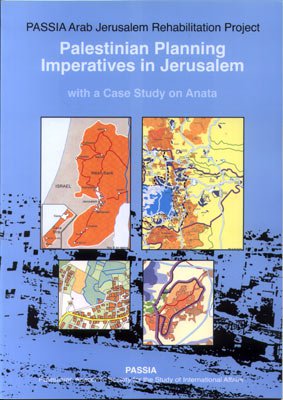Palestinian Planning Imperatives in Jerusalem – With A Case Study on Anata (PASSIA Arab Jerusalem Rehabilitation Project)
The overall purpose of the project was to examine the means by which to shape and ensure a viable future for Arab Jerusalem, primarily from the viewpoint of the citizens themselves. The project aimed to provide local communities with technical and organizational counsel for formulating and implementing local developmental strategies to achieve this end. The project focused on an outline for the rehabilitation of local communities in Arab Jerusalem and drew various scenarios of what can be done and what will happen if nothing is done. The findings were published in a book, supported by 17 colored maps and illustrated with numerous photos. The first part of this publication introduces an overall framework to examine the issue of development planning for Jerusalem with maps showing the difference between development as it is unilaterally pursued by Israel on the one hand, and development as it is needed to obtain an equitable Palestinian share in shaping the future of Jerusalem on the other. The second part illustrates how the principle of equitable development planning can be applied to a crucial city-section of Arab East Jerusalem neighborhoods and suburbs, focusing on a prospective alternative planning scheme for Anata township, compiled in cooperation with local citizens.
Overview
As part of its ongoing work on the Question of Jerusalem, the Palestinian Academic Society for the Study of International Affairs (PASSIA) launched the Arab Jerusalem Rehabilitation Project in early 1999, realizing the urgency for such an initiative.
In 1993, Israel and the PLO agreed to have a final status for Jerusalem negotiated by the end of a five-year transitional period that began in May 1994.
Today, however, seven years after the signing of the first Israeli-PLO Accords, Arab Jerusalem is facing an increasingly critical situation, and the prospects of recovering it as the future Palestinian capital, in more than just a symbolic sense, are decreasing dramatically.
The overall purpose of the project presented here was to examine the means by which to shape and ensure a viable future for Arab Jerusalem, primarily from the viewpoint of the citizens themselves. The project aimed to provide local communities with technical and organizational counsel for formulating and implementing local developmental strategies to achieve this end. The project focused on an outline for the rehabilitation of local communities in Arab Jerusalem and drew various scenarios of what can be done and what will happen if nothing is done.
From its outset, the project promoted a citizen-oriented, ‘bottom-up’ approach, getting representatives from the local community (i.e., Anata) involved in the various stages of the project, which included fieldwork and data compilation. The designs of previous development initiatives are disturbing in their lack of interaction with the population affected by the envisioned changes, whereas our approach produced highly practical and applicable information and valuable feedback on various development options.
The findings allow us to answer numerous questions: What kind of pressure is there on housing capacity? How much additional living space is needed? How much development do the authorities enable, and how much is really set aside by them? What pressures can be recognized on amenities such as green spaces, or on cultural-historical sites and characteristic traditional architecture? What communal private and public space is left accessible to citizens as a result of official zoning plans?
In providing this elementary tool of information that can be used and viewed by citizens, local councilors, institutions and researchers, the project hopes to facilitate municipal-level decision-making and mobilize civil self-initiative in protecting and restoring Arab neighborhoods in Jerusalem.

